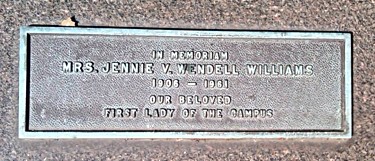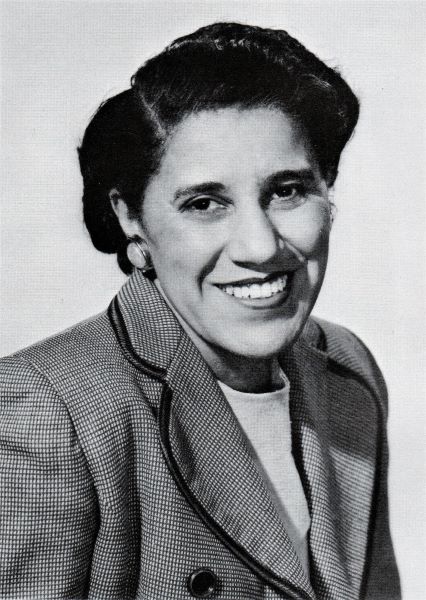Genevieve Wendell Williams
A modest brass marker bearing an unpretentious but heartfelt tribute sits beneath a magnolia tree adjacent to the University of Maryland Eastern Shore’s administration building. It reads:

During the 75th anniversary year of its founding, the institution and its popular president suffered the loss of First Lady Jennie V. Williams.
Born Genevieve Wendell on Oct. 4, 1906, she was second youngest of four children of African-American physician, Dr. Thomas T. Wendell, and his wife, Mary Alice Wendell, of Lexington, Ky.
Her father, who earned medical and pharmacy degrees from Meharry Medical College, was a “pioneer in [the] care of Kentucky’s mentally ill.” For 20 years, Dr. Wendell was staff physician at the Eastern State Hospital in Lexington, where he advocated for better care for African-American patients. A building at the hospital is name for him.

“Jennie V.,” as she would come to be known throughout her life, grew up in a well-to-family during the Roaring Twenties and the Harlem Renaissance. She undoubtedly was exposed to opportunities, socially and educationally, out of reach for most African-Americans of that era.
Jennie graduated in 1927 from Fisk University in Nashville, and two years later, earned her master’s degree from Columbia University in New York. She worked as a teacher in Tyler, Texas, then at Kentucky State College, where she met the tall, imposing dean of the college, John Taylor Williams. The couple was married at the college on Nov. 5, 1929, just 12 days after the stock market crash plummeted the nation into the Great Depression.
From 1929 through 1946, the Williamses made their home in Kentucky, where they raised their only child – a daughter, Lorelle. Mrs. Williams balanced her role as a wife and mother, with work and civic engagement. She was active in the Delta Sigma Theta sorority, an African-American civic organization, and she served as the first president its Beta Upsilon Sigma chapter (now Frankfort Alumnae chapter) in Lexington in 1945.
When her husband was appointed president of the college in Princess Anne in 1947, Mrs. Williams assumed her role as ‘first lady’ with ease. She was described as having “a sustained interest in academic excellence . . . and a never-flagging interest in the college’s ascendency on the athletic filed.” She exhibited that same character in her work in the Eastern Shore community.
Mrs. Williams was a member of St. Elizabeth’s Catholic Church in Pocomoke City, Md., the National Education Association, the Maryland State Teachers Association and The Links, Incorporated, an organization founded by African-American women dedicated to supporting the educational and cultural advancement of African-American youth.
It was said Mrs. Williams “was . . . keenly sensitive to discrimination with its accompanying injustices, yet she never allowed herself to be jarred out of her basic Christian moral balance.”
Following her last public appearance at Maryland State’s homecoming festivities in 1960, Mrs. Williams retreated from public life and fought a six-month battle with cancer, succumbing at their home on the campus March 15, 1961. She was 54.
Maryland State’s ROTC Honor Color Guard lined the Kiah gym/auditorium, where Catholic services were led by Father Rudolph Miller, rector of St. Elizabeth’s Catholic Church.
Following her death, the college’s Angel Flight Corps was named in her honor and the magnolia tree was planted in her memory. At the institution’s 125th anniversary, the latter stood tall a short distance from John T. Williams Hall, the administration building named in honor of her husband.
Mrs. Williams is buried in Greenwood Cemetery, Lexington, Ky.

